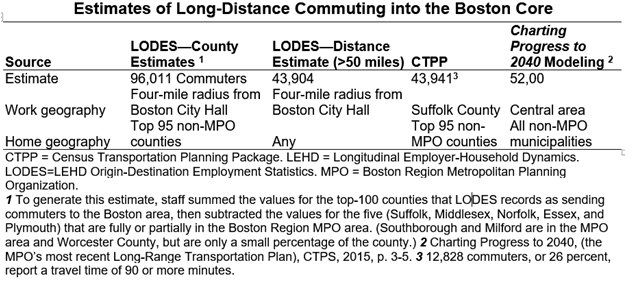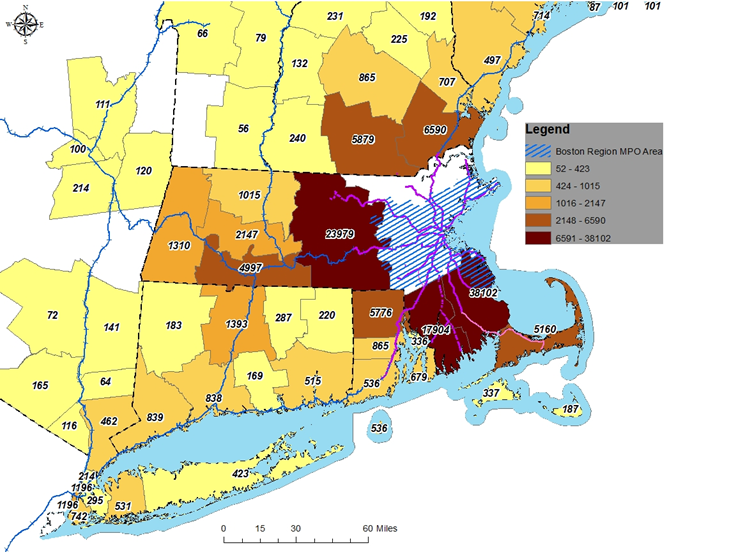 by Sandy Johnston, MPO Staff
by Sandy Johnston, MPO Staff
Sandy Johnston is a Transportation Planner and manager of the Unified Planning Work Program at CTPS. He has an abiding interest in quirky or misunderstood aspects of transportation planning and greatly appreciates the Boston Region MPO's creation of the Staff-Generated Research program to allow staff to pursue research interests.
The topic of long trips to work has been of considerable interest to the popular media recently. Since July 2017, the New York Times has published two major stories about people with long commutes in the New York City area and the San Francisco Bay Area. Here in Massachusetts, a Pew Charitable Trusts report released in June claimed that the population of “supercommuters” had grown by 45.4 percent from 2010 through 2015—the third-most of any state in the country.
At the November 2, 2017, Boston Region MPO meeting, I presented my research about people who commute over long distances into the urban core of the Boston region, documented in a report called Long-Distance Commuting in the Boston Region: Necessity or “Strategic Mobility Choice”?. I was inspired to start this research by the experience of having several friends who do commute long distances between Boston and other parts of New England.
Readers may have heard terms like super commuter, mega commuter, and extreme commuter used more or less interchangeably, as often they are. Technically, a US Census Bureau report has classified “extreme commuters” as those with a 90-or-more minute commute; “long-distance commuters” as those traveling 50 or more miles; and “mega commuters” as those whose trip is both 90-or-more minutes and 50-or-more miles. For simplicity’s sake, my analysis focuses on a specific set of long-distance commuters: those traveling into the core of the Boston region for work. However, my analysis does not just adopt the 50-mile definition; it also uses a variety of datasets to provide a multifaceted look at the long-distance commute market.
My research attempts to answer two relatively simple sets of questions. First, how many people commute into the core of the Boston region from a long distance, and where do they come from? Second, who are the people choosing such commutes, why do they do so, and what are their demographic characteristics as a group?
The answer to the first set of questions is hard to nail down with certainty. As the graphic below shows, different data sources provide different answers.

The map below shows the data from just one of these sources.

In answering the second set of questions, I draw on two different types of information. First, I review the (minimal) existent planning and scholarly literature about long-distance commuters. This literature indicates that many (though not all) long-distance commuters are highly educated professionals who make their lifestyle choice for strategic reasons such as balancing a two-job household; valuing a place of residence; and having the ability to telework.
While quantitative data on such commuters is scarce, I was able to paint a more exact demographic portrait of the region’s long-distance commuters thanks to previous MPO staff work, and data generously shared by the Northern New England Passenger Rail Authority (NNEPRA). We have previously explained staff’s analysis of the 2011 Massachusetts Travel Survey. A fresh look at data from that survey, in comparison to data provided by NNEPRA from 2016 onboard surveys, shows some areas of remarkable agreement, as illustrated in the graphic below.

Together, these datasets provide a portrait of long-distance commuters into the Boston-area core: They are mostly highly educated; earn a middle-class income or greater; and are largely male. To some extent, this data provides something of a counterbalance to the image in popular media of long-distance commuters who are forced into such a commute by rising housing prices or other exigencies.
Among the most interesting findings is that many long-distance commuters are “non-traditional” commuters in another way as well: Many do not make their commuting trip every day. In addition to evidence from research literature, this conclusion was backed by NNEPRA’s survey data, which shows that passengers who identified their trip purpose as “commuting” or “business” traveled on average between two and three days per week. While perhaps not surprising per se, this finding may help account for some of the discrepancies observed in the Census data about the number of long-distance commuters in the Boston region: While the American Community Survey asks people where the last place they worked was, the LODES data is reflective of administrative-type data—anonymized records of a person’s places of employment and residence. In other words, ACS may be catching some, but not all, long-distance commuters, as many of them work at home only part time.
My report cites a variety of potential actions that the MPO or other entities could take to further planners’ understanding of long-distance commuting and make such commutes safer and easier, should people continue to choose them. Some of the recommendations—such as the idea of re-evaluating the MPO’s analytical approach to high-occupancy vehicle lanes on freeways using recommended new federal criteria that emphasize measuring the “cumulative delay of all people” using roadways—are elements that the MPO can adopt on its own, while others would require action by other bodies, alone or in cooperation with each other (see table below).

Many of these recommendations revolve around a conclusion garnered from my research: that long-distance commuters express a preference for traveling by transit rather than automobile.
As a personal research project, my report is not intended to provide a comprehensive look at the issue of extreme, mega, super, or long-distance commuting. Rather, it is an initial look at a challenge that has received some media attention and might soon show up on the MPO’s radar. While the number of long-distance commuters in the Boston region remains small relative to the full job market, low-cost interventions based on coordinating transportation services and spreading information can make a disproportionate impact toward easing these difficult commutes. Hopefully, this work can help to shape a brighter future for all such commutes.
This post summarizes work on a research report funded by the MPO’s Staff-Generated Research Topics program. The program is intended to produce interesting and timely information for the MPO’s consideration; support staff members’ professional development; and yield creative solutions for transportation planning problems. Any views expressed in program products are those of the staff member who conducted the research and are not necessarily those of the MPO.
